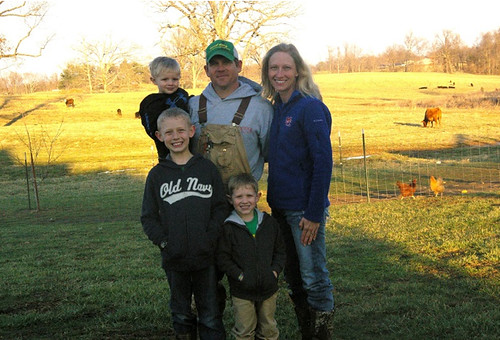
When Jake and Jondra Shadowen from Benton, Ky. got married 14 years ago, they decided to buy a 26-acre ranch with a goal of raising a healthy herd of cattle. Today, thanks to hard work and conservation, they maintain a strong herd of 26 cattle, up from 11 when they first began.
They worked with USDA’s Natural Resources Conservation Service to implement a rotational grazing system, which breaks up large pastures into smaller ones. A rotational grazing system allows for grass to grow faster and quicker and prevents soil from becoming prone to erosion.
Healthier grass means healthier forage, or food for the cattle. Jake Shadowen aims to constantly improve the quality of his cattle by improving forage. Through the Conservation Stewardship Program (CSP) and other Farm Bill conservation programs, he received technical and financial assistance to put in cross fencing and to implement other conservation activities, or enhancements.
CSP helps agricultural producers maintain and improve their existing conservation systems and adopt additional conservation enhancements to address priority resources concerns. Participants earn CSP payments for conservation performance – the higher the performance, the higher the payment.
As part of a CSP, Shadowen sends fecal samples for lab analysis six times a year to determine cattle health – and see how the cattle are responding to better forage. Shadowen plants a mix of cool-season grasses such as tall fescue, orchardgrass and red clover.
Also, as part of the program, he has added wildlife friendly fences, escape routes in water troughs and pollinator habitat to the farm. He marked fences with flags in locations that are the main thoroughfares for deer, which help prevent deer from getting snagged or injured. He also added the escape ladders to water troughs to keep birds and small animals from getting trapped. Additionally, he plants pollinator-friendly flowers and grasses on the land to help improve the health of bees, butterflies and other crucial pollinators.
CSP is the perfect program for landowners like the Shadowens, who want to make improvements to their existing conservation system and address resource concerns like soil health and water quality. The conservation work benefits his cattle herd as well as the surrounding environment.
Their farm is a model for the community as it has been used for soil health demonstrations to help other landowners see the benefit of rotational grazing and other conservation practices.
In addition to ranching, Jake is a full-time electrician and Jondra works part-time as a dental hygienist. They have three sons.
“My wife and I were both raised on a farm and even though you don’t think the farm work means much at the time, you appreciate it later in life,” Jake Shandowen said of raising his children on the land.
To get started with NRCS, visit your local USDA Service Center or www.nrcs.usda.gov/GetStarted.

